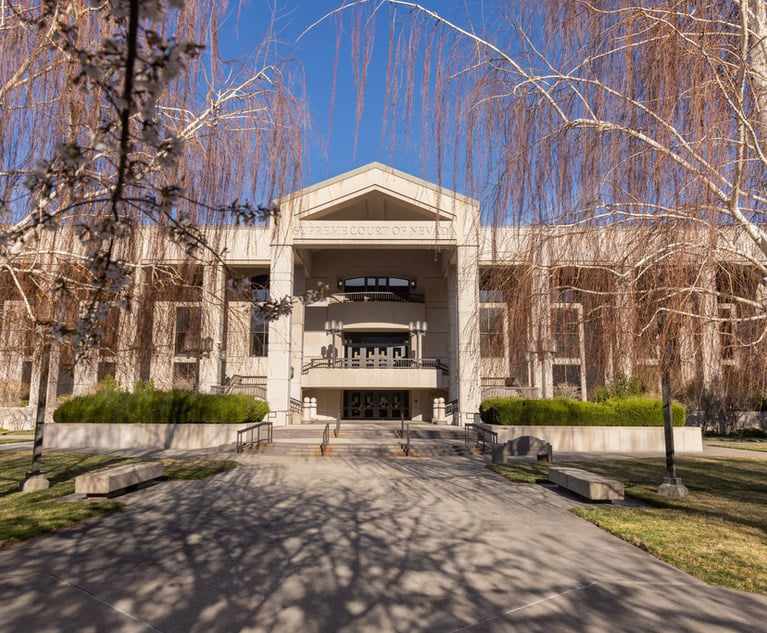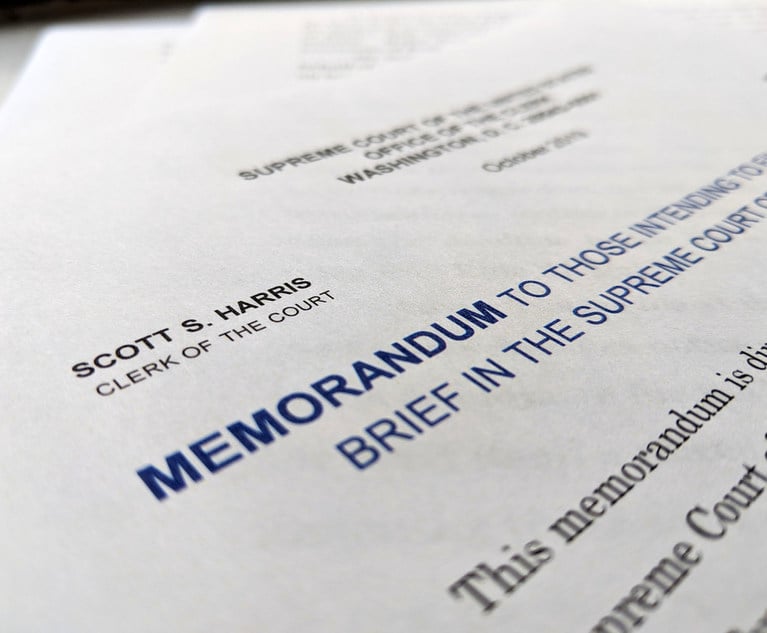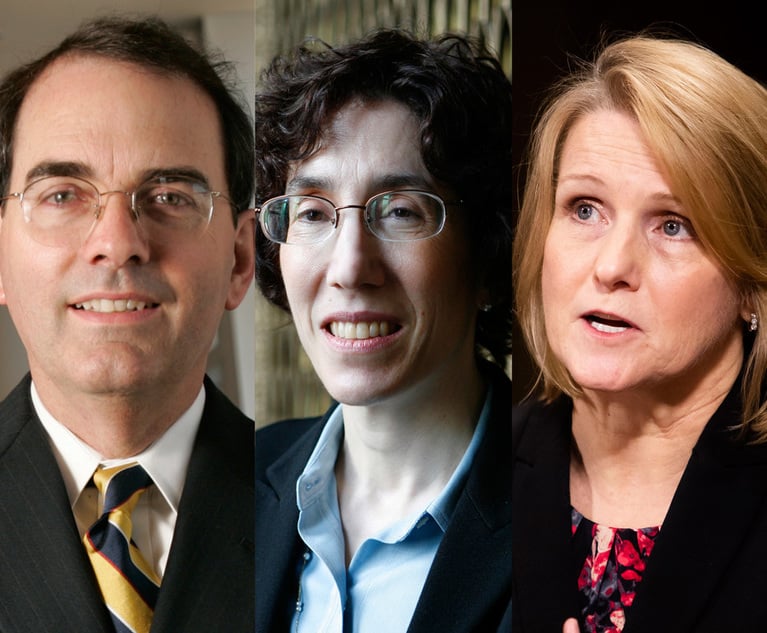Kagan Says Repeat Players at SCOTUS 'Know What It Is We Like'
Justice Elena Kagan recently told University of Wisconsin law students that arguing before the U.S. Supreme Court is "pretty much a nightmare" for lawyers, but not for the "repeat players" of the Supreme Court Bar who know what the justices like, and who know what they should and should not do.
September 13, 2017 at 02:04 PM
4 minute read
Justice Elena Kagan recently told University of Wisconsin Law School students that arguing before the U.S. Supreme Court is “pretty much a nightmare” for lawyers, but not for members of the Supreme Court Bar.
“We are so, so lucky,” Kagan said during a Sept. 8 conversation with Dean Margaret Raymond, a longtime friend of the justice. “We have an extremely high caliber bar.”
Many of the arguments, she said, are made by “repeat players” who “really know the court, who know the process of arguing before the court, who know what it is we like, who know what they should be doing, what they shouldn't be doing.”
Kagan said that “arguing in front of courts is difficult, but in front of the Supreme Court it's pretty much a nightmare because you have a lot of very, very active people who ask a ton of questions.”
She continued: “It's very rapid fire. You have to have really thought through stuff before you get to the podium. Often the justices aren't really asking you questions; they don't really care about the answers you give. They're making points to their colleagues. I say this not in a pejorative way. I do it all the time, and I think it's actually an important part of the process that we're talking with each other up there. But it makes it extremely hard for the lawyers who want to occasionally interject at some point. It's a good thing to realize so let's give these people a little bit of a break.”
The emergence of a specialized Supreme Court Bar hasn't gone without notice—and criticism.
A Reuters investigation published in 2014, pointing to legal scholars, said the repeated appearance of the same advocates “has turned the Supreme Court into an echo chamber—a place where an elite group of jurists embraces an elite group of lawyers who reinforce narrow views of how the law should be construed.” A 2008 paper from Richard Lazarus, a Harvard Law School professor, confronted and questioned the rise and influence of the “elite private sector group of attorneys” that he called the modern Supreme Court Bar.
Kagan said seeing good lawyering by the high court bar taught her that there is no single right way to make an argument. She recounted an anecdote about returning from a court conference when, because of a flight delay, she spent several hours in the airport with two veteran high court advocates. The two attorneys had dramatically different argument styles. In discussing argument styles, one of the lawyers described himself as a hot lawyer and the other as a cold lawyer, she recalled.
“One gets up to the podium and the place just like throbs with energy,” Kagan said. “Everybody leans forward in their chairs. There's just so much tension and energy in the air. He's just tremendous, knocking everything out of the ballpark. The other is calm, cool and collected as can be. He just sort of cools down the temperature of the room, and is Mr. Reasonable Man. Surely you have to believe everything he says because he says it in such a calm kind of way, sort of a slowwww way.”
Both lawyers, however, she added, are tremendous advocates. “So a lot of it is personality, a lot of it is just what feels comfortable, but that said, you've got to listen to the judges,” Kagan said.
In an earlier recounting of the anecdote, Kagan said the two lawyers with her that day were Sri Srinivasan (Mr. Cool)—now a judge on the U.S. Court of Appeals for the D.C. Circuit—and Kirkland & Ellis partner Paul Clement, the Mr. Hot at the podium.
Related Articles:
|- Kagan Recounts Obama Vetting Her for 'Another Very Good Job' That Wasn't SG
- Take a 'Journey' Through the Justices' Bookshelves
- Kagan: Law Schools Must Do More to Boost Student Writing Skills
- Solicitor General's Office Fills Ranks With Big Law Hires
- When It's Summertime, Justices Hit the Road and Speak Out
This content has been archived. It is available through our partners, LexisNexis® and Bloomberg Law.
To view this content, please continue to their sites.
Not a Lexis Subscriber?
Subscribe Now
Not a Bloomberg Law Subscriber?
Subscribe Now
NOT FOR REPRINT
© 2024 ALM Global, LLC, All Rights Reserved. Request academic re-use from www.copyright.com. All other uses, submit a request to [email protected]. For more information visit Asset & Logo Licensing.
You Might Like
View All
Divided 5th Circuit Shoots Down Nasdaq Diversity Rules

Nevada Supreme Court to Decide Fate of Groundbreaking Contingency Cap Ballot Measure
5 minute read
Lawyers, Law Groups Oppose Proposal to Require Court Approval for Amicus Briefs

9th Circuit Judges Weigh if Section 230 Shields Grindr From Defective Design Claims
Trending Stories
- 1The Key Moves in the Reshuffling German Legal Market as 2025 Dawns
- 2Social Media Celebrities Clash in $100M Lawsuit
- 3Federal Judge Sets 2026 Admiralty Bench Trial in Baltimore Bridge Collapse Litigation
- 4Trump Media Accuses Purchaser Rep of Extortion, Harassment After Merger
- 5Judge Slashes $2M in Punitive Damages in Sober-Living Harassment Case
Who Got The Work
Michael G. Bongiorno, Andrew Scott Dulberg and Elizabeth E. Driscoll from Wilmer Cutler Pickering Hale and Dorr have stepped in to represent Symbotic Inc., an A.I.-enabled technology platform that focuses on increasing supply chain efficiency, and other defendants in a pending shareholder derivative lawsuit. The case, filed Oct. 2 in Massachusetts District Court by the Brown Law Firm on behalf of Stephen Austen, accuses certain officers and directors of misleading investors in regard to Symbotic's potential for margin growth by failing to disclose that the company was not equipped to timely deploy its systems or manage expenses through project delays. The case, assigned to U.S. District Judge Nathaniel M. Gorton, is 1:24-cv-12522, Austen v. Cohen et al.
Who Got The Work
Edmund Polubinski and Marie Killmond of Davis Polk & Wardwell have entered appearances for data platform software development company MongoDB and other defendants in a pending shareholder derivative lawsuit. The action, filed Oct. 7 in New York Southern District Court by the Brown Law Firm, accuses the company's directors and/or officers of falsely expressing confidence in the company’s restructuring of its sales incentive plan and downplaying the severity of decreases in its upfront commitments. The case is 1:24-cv-07594, Roy v. Ittycheria et al.
Who Got The Work
Amy O. Bruchs and Kurt F. Ellison of Michael Best & Friedrich have entered appearances for Epic Systems Corp. in a pending employment discrimination lawsuit. The suit was filed Sept. 7 in Wisconsin Western District Court by Levine Eisberner LLC and Siri & Glimstad on behalf of a project manager who claims that he was wrongfully terminated after applying for a religious exemption to the defendant's COVID-19 vaccine mandate. The case, assigned to U.S. Magistrate Judge Anita Marie Boor, is 3:24-cv-00630, Secker, Nathan v. Epic Systems Corporation.
Who Got The Work
David X. Sullivan, Thomas J. Finn and Gregory A. Hall from McCarter & English have entered appearances for Sunrun Installation Services in a pending civil rights lawsuit. The complaint was filed Sept. 4 in Connecticut District Court by attorney Robert M. Berke on behalf of former employee George Edward Steins, who was arrested and charged with employing an unregistered home improvement salesperson. The complaint alleges that had Sunrun informed the Connecticut Department of Consumer Protection that the plaintiff's employment had ended in 2017 and that he no longer held Sunrun's home improvement contractor license, he would not have been hit with charges, which were dismissed in May 2024. The case, assigned to U.S. District Judge Jeffrey A. Meyer, is 3:24-cv-01423, Steins v. Sunrun, Inc. et al.
Who Got The Work
Greenberg Traurig shareholder Joshua L. Raskin has entered an appearance for boohoo.com UK Ltd. in a pending patent infringement lawsuit. The suit, filed Sept. 3 in Texas Eastern District Court by Rozier Hardt McDonough on behalf of Alto Dynamics, asserts five patents related to an online shopping platform. The case, assigned to U.S. District Judge Rodney Gilstrap, is 2:24-cv-00719, Alto Dynamics, LLC v. boohoo.com UK Limited.
Featured Firms
Law Offices of Gary Martin Hays & Associates, P.C.
(470) 294-1674
Law Offices of Mark E. Salomone
(857) 444-6468
Smith & Hassler
(713) 739-1250










